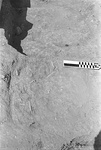| Collection: | Corinth | |
| Type: | Basket | |
| Name: | NB986 B6 P24 | |
| Area: | Panaghia north | |
| Category: | Basket/zembil | |
| Notebook: | 986 | |
| Context: | 6 | |
| Page: | 24 | |
| Date: | 2007/04/23 | |
| Stratum: | Burial, light, yellowish-brown, silty, 5% inclusions, well sorted, pebbles | |
| Notes: | Excavation of an infant burial first uncovered in the cleaning basket (B 1) for our trench. This grave, grave 2007-2, was first thought to be a part of grave 2007-1, though further excavation (B 2) revealed that this was a second burial with its own cutting. This burial is described on pages 26-27. No associated grave goods were found with the burial and we found no fragments of pottery or other objects in the fill of this burial. Once the fill of the grave and the remains were removed, we closed the basket. Grave 2007-2 is a primary articulated burial in an oval pit located c. 2.25 meters south of west of W 296, taken from the northwest corner of the wall. This places the burial within the western part of the 16th to 18th century AC cemetery in Panaghia Field. The cuttings for the burial were discovered during the initial cleaning of the trench (B 1) as well as during the excavation of grave 2007-2 (B 2); the presence of human remains was suggested by an aligned long bone and articulated ribs. The pit for this burial is .50 m long by . 32 m wide, and the body, preserved only from the upper rib cage to upper femur, measures .48 m long by .25 m wide. Stratigraphically, the pit is at 91.825 m at its top elevation and 91.778 along its bottom elevation. The burial was excavated by Tasos Kakouros and Thanasis Mangorakis on the 23rd and 24th of April, 2007. The bones are in poor condition and not complete. The skeleton appears to have been disturbed by later activity, perhaps the same activity that removed the lower extremities of the remains in grave 2007-1. The cranium is completely absent, while small fragments of what may be the scapula and pelvis are preserved. In addition, one cervical vertebra, one tooth, and the shaft of one of the bones of the right leg (femur?) have also been preserved along with a fragment of the shaft of one of the bones of the right arm (radius?). Two of the bones of the left arm (humerus and radius?) have survived, though in fragmentary form. A majority of the rib cage was present and articulated, though so badly degraded that the ribs could not be lifted intact. The grave cut was discovered before its excavation, and so the majority of post mortem breaks occurred between the time of burial and the time of excavation. The body is supine and was oriented with its head to the west at the time of burial. The upper portion of the right arm may have flared out from the torso, based on the position of the partially preserved radius, and the position of the two bones of the left arm also suggest a slight flaring of the elbow at the time of burial; however, the remains are too poorly preserved to securely reconstruct the body’s configuration at the time of burial. The measurement taken over the spine was 99˚ east of north with a cutting for the burial at 98˚ east of north. The skeleton is situated tightly within the grave cut, with the fragment of the right radius only .02 m inside of the cutting, and the fragments of the left arm bones only .05 m inside the cutting. The feet presumably would have been oriented toward the east, though they are now absent. Associated objects: None | |
| Period: | No precise date (NPD) | |
| Grid: | 417.8-417.5E, 978.6-979.4N | |
| XMin: | 417.5 | |
| XMax: | 417.8 | |
| YMin: | 978.6 | |
| YMax: | 979.4 | |
| Site: | Corinth | |
| City: | Ancient Corinth | |
| Country: | Greece | |
| Masl: | 91.778-91.825m. | |
| References: | Image: bw 2007 011 22 Image: digital 2007 0189 Image: digital 2007 0190 |
|
Show Everything (259,852) Publications (1,214) Reports (75) Places and Monuments (297) Plans and Drawings (2,887) Images (88,930) Objects (70,348) Coins (18,459) Notebooks (443) References Images (3) Classifications Sign in Provide feedback |
|


